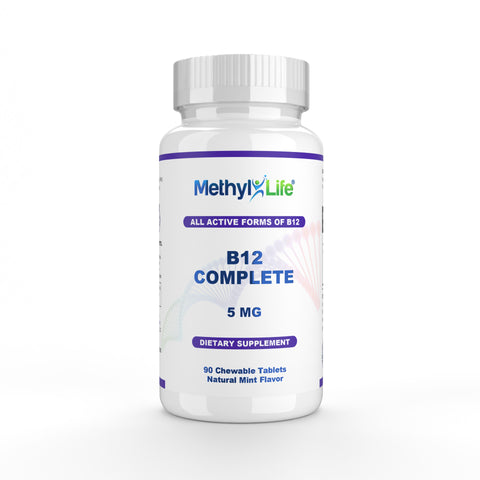
How much B12 should you take per day?
Product Recommendations
B12 Complete 5 mg
$32.00
- All 3 Bioactive Forms of B12 for Full-Spectrum Absorption
- Methylcobalamin B12, Hydroxy B12 & Adenosylcobalamin
- 3rd-Party Tested for Purity, Potency & Safety
- 90 Vegan, Non-GMO, Chewable Mint Tablets

Written By:
Katie Stone - Naturopath
Medical Reviewer:
Kari Asadorian - BSN, RN
Edited By:
Jamie Hope - Methyl-Life® FounderUpdated On:
March 24, 2025Forms of B12
Vitamin B12 is available in four different forms. The three natural, bioactive forms include methylcobalamin, adenosylcobalamin, and hydroxocobalamin. The synthetic form, cyanocobalamin, is the form most commonly used in supplements and foods, as it is cheap to produce. Approximately 50-98% of the injected cyanocobalamin is in the urine, mostly excreted within the first eight hours.1
- Methylcobalamin occurs naturally in the body and assists in producing red blood cells, DNA and other physiologic functions.
- Adenosylcobalamin also exists naturally, is required for energy metabolism, but is less commonly used in vitamin B12 supplements. Adenosylcobalamin is the active form used by the mitochondria (the powerhouse of every cell).2
- Hydroxocobalamin is a precursor to methylcobalamin and adenosylcobalamin. It is most commonly used in injections and is retained in the body for longer.
- Cyanocobalamin must be converted to the active form before it can be used in the body. However, this conversion process may be impaired in people with MTR/MTRR mutations.
What affects B12 absorption?
Many factors affect the way B12 is absorbed and used in the body, including gut health, age, diet, interference with medications and health conditions.
Certain genetic variants may affect the proteins involved in vitamin B12 absorption, cellular uptake and intracellular metabolism. For example, mutations of the MTR or MTRR genes can affect the conversion of B12 to its active form, which affects the absorption of synthetic cobalamin in the body.
Dosage recommendations per age
Vitamin B12 dosage recommendations as per guidelines from WHO and NIH.3
The absorption rate of a 500 mcg B12 dose is only around 2%, while a 1000mcg dose is around 1.3%.14
Adults under 50: ~2.4 mcg per day
Adults over 50: 2.4 mcg per day
Older adults are advised to supplement with B12 where necessary due to the reduced stomach acid and intrinsic factor and/or medications.
Pregnant women: ~2.6 mcg per day
Increased demand due to supporting the development of the fetal brain and nervous system.
Breastfeeding women: ~2.8 mcg per day
B12 supports a child’s growth and neurological development through breastmilk.
Children
Infants (0–6 months): 0.4 mcg/day
7–12 months: 0.5 mcg/day
1–3 years: 0.9 mcg/day
4–8 years: 1.2 mcg/day
9–13 years: 1.8 mcg/day
14–18 years: 2.4 mcg/day
Vegans and vegetarians are advised to supplement with B12 as it is only present in animal foods.
People who have MTHFR
People with MTHFR mutations are advised to supplement with active forms of B12 to support proper methylation.
Consult your healthcare practitioner regarding your B12 levels and appropriate supplementation.
Dosage and frequency of B12 depending on the supplement form
B12 tablets/capsules
Cyanocobalamin: typical supplement values are around 25-100 mcg daily. High doses (1,000–2,000 mcg/day) may be recommended for those with impaired absorption. Methylcobalamin: Up to 1,000 mcg/day for general health or in cases of deficiency.
High doses of vitamin B12 of up to 1,000 mcg are considered safe because the body will use the amount that it needs, and any excess will be flushed out through urine.
A study comparing bioavailability of crystalline B12 at different oral doses found that the body can only absorb about 1-1.2 mcg B12 via the gut per dose. Small doses (around 2-3 µg) were absorbed at a rate of around 50%, and as the dose increased, the rate of absorption decreased.
Absorption rate of a 5 mcg dose was around 27%, and at 10 µg, only 15%. High-dose supplements were not found to proportionally increase absorption.5
In some cases, sublingual B12 supplementation may be more effective than oral administration.
Sublingual B12
Sublingual lozenges/drops are available as cyanocobalamin or methylcobalamin. Dosages may range from 100-1,000mcg daily.
Methyl-Life’s Active B12 product is one of the few that contains all three active forms of B12 (methylcobalamin, adenosylcobalamin, and hydroxocobalamin) in a sublingual tablet.
Sublingual B12 is absorbed directly through the mucus membranes in the mouth, bypassing the digestive tract and intrinsic factor. This is ideal for people with impaired absorption.
B12 injections
Intramuscular B12 injections are given as hydroxocobalamin or cyanocobalamin. Dosage is usually 1,000 mcg per injection. These are given every 1–2 weeks initially, then monthly depending on the severity and cause of deficiency.
B12 injections are advised for those with severe deficiency and/or impaired absorption due to
pernicious anemia or surgery.
What is considered a high dosage of B12?
A high dosage of B12 is around 500-1,000 mcg a day, either given via oral supplements or B12 injections. These dosages are typically given to treat deficiency resulting from pernicious anemia, gastrointestinal disorders (such as Crohn’s disease), malabsorption syndromes, gastric surgeries and long-term use of medications (such as proton pump inhibitors).
B12 is a water-soluble vitamin, so anything the body cannot use immediately is excreted in urine.
There is no upper limit (UL) because toxicity due to high dosage is unlikely. In general, high-dose B12 supplementation is safe.
Who may need high dosages of B12:
- People with absorption difficulties due to insufficient stomach acid, lack of intrinsic factor (pernicious anemia), or gastrointestinal surgery6
- Vegans/strict vegetarians
- People affected by certain genetic variants, e.g. MTR, MTRR, or TCN2 which impair how B12 is metabolized or delivered to tissues.
How much B12 should you take per day?
Key takeaways
-
 B12 is essential for supporting healthy function of the brain and nervous system.
B12 is essential for supporting healthy function of the brain and nervous system.
-
 High dosages of B12 (1000-5000 mcg) are considered safe, as excess is flushed out of the body.
High dosages of B12 (1000-5000 mcg) are considered safe, as excess is flushed out of the body.
-
 High dosage B12 may be necessary for those with impaired absorption.
High dosage B12 may be necessary for those with impaired absorption.

Product Recommendations
Vitamin B12 5000 mcg (Methylcobalamin B12 Complete) – 3 Bioactive Forms
$32.00
- All 3 Bioactive Forms of B12 for Full-Spectrum Absorption
- Methylcobalamin B12, Hydroxy B12 & Adenosylcobalamin
- 3rd-Party Tested for Purity, Potency & Safety
- 90 Vegan, Non-GMO, Chewable Mint Tablets
Frequently Asked Questions about B12 dosages
Yes, 1,000 mcg is a standard supplemental dose of B12. This dose can be taken daily as anything the body cannot use immediately is excreted in urine.
Not likely. Toxicity from high doses of B12 is fairly unlikely as it is a water-soluble vitamin, so any excess will be flushed out. It is considered safe to take in high doses.7
No, daily dosages of 5,000 mcg B12 methylcobalamin are considered safe. Methylcobalamin is the active form of B12 and risk of toxicity from high doses is very low.
References
-
Advait Vasavada, Preeti Patel, Devang K. Sanghavi; "Cyanocobalamin"; StatPearls [Internet]; 2024 Jan
https://www.ncbi.nlm.nih.gov/books/NBK555964
-
Patryk Mucha, Filip Kus, Dominik Cysewski, Ryszard T Smolenski, Marta Tomczyk; "Vitamin B12 Metabolism: A Network of Multi-Protein Mediated Processes"; International journal of molecular sciences; 2024 Jul
https://pmc.ncbi.nlm.nih.gov/articles/PMC11311337
-
Office of Dietary Supplements, National Institutes of Health; "Vitamin B12 Fact Sheet for Consumers"; 2021 Jul
https://ods.od.nih.gov/pdf/factsheets/vitaminb12-consumer.pdf
-
Ralph Carmel; "How I treat cobalamin (vitamin B12) deficiency"; Blood; 2008 Sep
https://pubmed.ncbi.nlm.nih.gov/18606874/
-
Sindhu Kashyap, Poorvikha Gowda, Roshini M Pasanna, Ambily Sivadas, Harshpal S Sachdev, Anura V Kurpad, Sarita Devi; "The Oral Bioavailability of Vitamin B12 at Different Doses in Healthy Indian Adults"; Nutrients; 2024 Nov
https://pubmed.ncbi.nlm.nih.gov/39683551/
-
Catherine Qiu Hua Chan, Lian Leng Low, Kheng Hock Lee; "Oral Vitamin B12 Replacement for the Treatment of Pernicious Anemia"; Frontiers in medicine; 2016 Aug
https://pmc.ncbi.nlm.nih.gov/articles/PMC4993789/
-
A S M Al Amin, Vikas Gupta; "Vitamin B12 (Cobalamin)"; StatPearls [Internet]; 2023 Jul
https://www.ncbi.nlm.nih.gov/books/NBK559132/

About the Author
Katie is a qualified Naturopath (BNatMed) and freelance writer from New Zealand. She specializes in all things health and wellness, particularly dietary supplements and nutrition. Katie is also a dedicated runner and has completed more half-marathons than she can count!
Related Articles

What is the Best Form of B12 for You?
Written By: Jamie Hope - Methyl-Life® Founder

Like what you read?
Please subscribe to get more content like this sent to your inbox.
Share This Article
| Age | Estimated average requirement (mcg) | Recommended nutrient intake (mcg) |
|---|---|---|
| 1-3 years | 0.7 | 0.9 |
| 4-8 years | 1.0 | 1.2 |
| 9-13 years | 1.5 | 1.8 |
| >14 years & Adults | 2.0 | 2.4 |
| Pregnant women | 2.2 | 2.6 |
| Breast-feeding women | 2.4 | 2.8 |
Trusted by Experts. Backed by Science.
Trusted professionals crafting original content backed by verified research. Since 2012, Methyl-Life® has been dedicated to providing evidence-based education to help individuals better understand methylation and nutritional wellness.
-

Expert-authored education
Every article and guide is written or reviewed by professionals specializing in methylation science and nutritional biochemistry.
-

Research-verified information
Our content references peer-reviewed studies and verified data, ensuring accuracy, integrity, and real-world relevance.
-

Educational leadership since 2012
A founder-led team collaborating with clinicians, researchers, and health writers to make complex science accessible and actionable.
-

Transparent and trustworthy
All educational materials undergo internal review for scientific accuracy, compliance, and clarity before publication.
Blog Categories
Table of Contents
Product Recommendations
Vitamin B12 5000 mcg (Methylcobalamin B12 Complete) – 3 Bioactive Forms
$32.00







